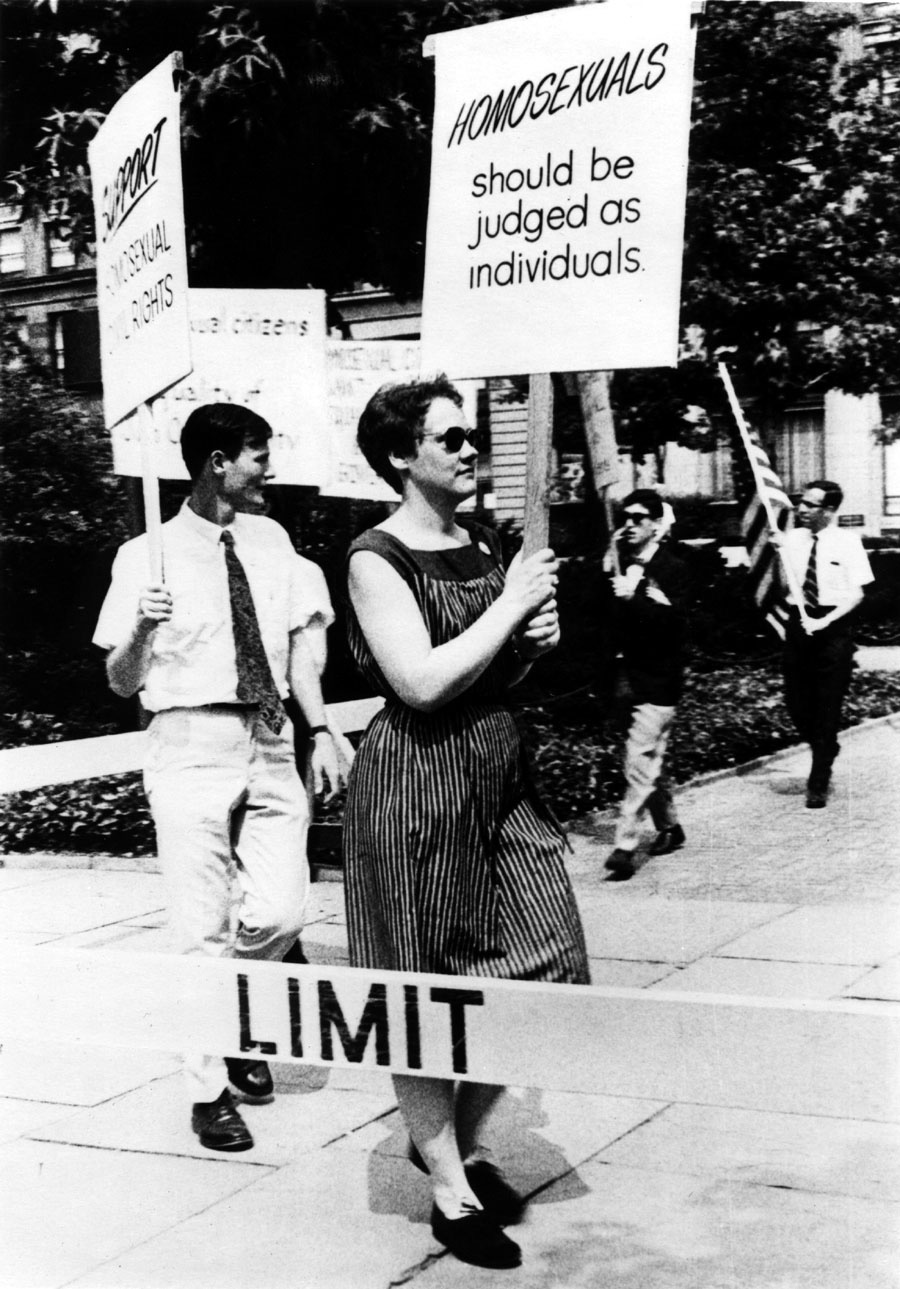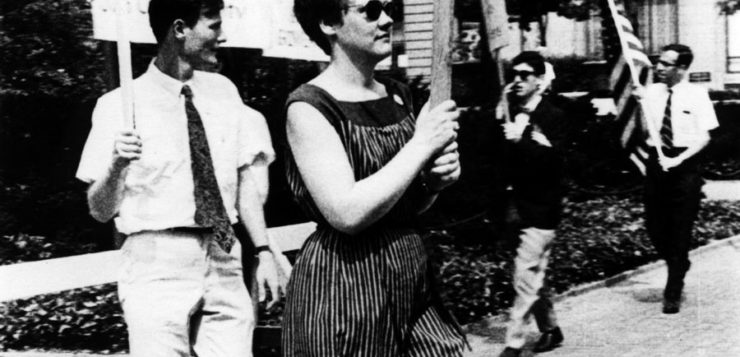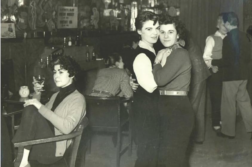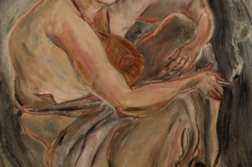BORN IN VIENNA, Austria, on July 31, 1932, to an official of the U.S. diplomatic corps and his wife, Barbara Gittings was a daughter dedicated to freedom. With passion, creativity, and relentless determination, she helped shape and lead one of the 20th century’s most significant struggles for social change, the gay and lesbian rights movement. Remarkably for a full-time, lifelong activist, she never forgot to stop and smell the roses—or, more accurately in her case, to sing with the chorale. She loved music, film, theater, literature, and good times; she believed fervently that a sense of humor was essential in fighting for gay visibility and civil rights.
Raised in Wilmington, Delaware, where her proclivity for crushes on classmates at the Catholic girls’ school she attended kept her from the National Honor Society, Barbara Gittings was barely out of her teens when she began her search for reliable data on same-sex love. Her legendary skills as a researcher surfaced in the late 40’s and early 50’s as she sought out the handful of books, and their authors, that discussed homosexuality without condemning it. On a quest to find “my people,” Gittings contacted Donald Webster Cory (Edward Sagarin), author of The Homosexual in America, in 1955. He directed her to the Mattachine Society, which in turn sent her to the just-formed Daughters of Bilitis (DOB).
She burst onto the tiny homophile scene in 1956, when she made California her vacation destination that summer. She stopped first in Los Angeles and then in San Francisco. “We met her plane,” Phyllis Lyon, co-founder of the Daughters of Bilitis, remembers. “She was a cute, curly-haired young woman wearing a shift and sandals. I remember she had this satchel, a backpack—I’d never seen anything like it. Or her.”

Gittings attended a DOB meeting where the discussion centered on plans to start a newsletter. Within two years, she was tapped by Lyon and her partner, DOB co-founder Del Martin, to start a chapter of the Daughters on the East Coast. She took on the task with the zest she brought to everything she did, building (with co-founder Marion Glass) the New York chapter into one of the largest and most important chapters in the country. Working closely with the Mattachine Society in New York and Washington, the New York DOB was instrumental not only in bringing more women into the homophile fold but also in building regional and national coalitions with gay men.
In 1963, Gittings assumed the editorship of DOB’s monthly magazine The Ladder. It would prove to be one of her most significant contributions, both to DOB and to the lesbian and gay rights movement. She brought her wide-ranging knowledge of literature, her interest in science and psychology, and her cosmopolitan sensibilities to the mimeographed newsletter, helping to transform it into a respected magazine that featured “real” lesbians on the cover. She put the tagline “A Lesbian Review” on the front and removed the warning “for adults only,” which led to one of many disagreements with DOB leaders in San Francisco, often captured in typewritten, single-spaced, three- to five-page missives sent from her home in Philadelphia. Gittings was joined in her DOB work by photographer Kay “Tobin” Lahusen, whom she met at a picnic in Rhode Island in 1961. Their partnership, in love and in the fight for gay liberation, lasted for the next 45 years.
But by 1966, DOB strictures and criticisms led Barbara and Kay to put their energies into activism beyond the Daughters. Gittings was one of the first to take part in gay and lesbian civil rights demonstrations, marching with picket signs at the White House, the Pentagon, and Independence Hall in Philadelphia from 1965 to 1969. She helped staff the famous, outrageous “Hug A Homosexual” booth at the 1971 American Library Association (ALA) annual conference in Dallas. As was typically Barbara, she not only happily hugged other homosexuals but was photographed enthusiastically kissing author Isabel Miller on the lips while the librarians looked on in amazement. She continued to work with the ALA from 1971 to 1986 and her leadership of its Gay Task Force was a highlight of her life, connecting her with people around the world as she created, updated, copied, and mailed out thousands of her “Gay Bibliography” sheets, which grew from one page to sixteen.
Barbara also helped to promote gay and lesbian acceptance within another crucially important American institution, the American Psychiatric Association. She helped create exhibits such as “Homophobia: Time for Cure” and “Gay Love, Good Medicine” with her friend and fellow activist Franklin Kameny at the APA’s annual meetings in the early 1970’s. She was responsible for convincing gay “Doctor H. Anonymous” (John Fryer) to speak to his colleagues in 1972. Although he appeared in disguise, it was a historic encounter with one of their own that the good psychiatrists in the audience could not ignore. The next year, in 1973, the APA removed homosexuality from its list of mental disorders. “All of a sudden, we were cured!” remarked Barbara recently. In 2006, she received the Dr. John Fryer Award from the American Psychiatric Association.
For the last fifty years, Barbara’s belief in gay visibility and activism has never faltered, nor has her generosity to researchers, writers, historians, media makers, politicians, students, and friends of friends, even when she battled the devastating effects of cancer. I had the privilege of getting to know Barbara Gittings in 1996 while interviewing former members of the Daughters of Bilitis for the first full-length history of the group, Different Daughters: A History of the Daughters of Bilitis and the Rise of the Lesbian Rights Movement. Phyllis Lyon and Del Martin introduced us at a raucous dinner party at Kay and Barbara’s home in our shared hometown of Wilmington, Delaware. For the last ten years, we have visited or e-mailed, sometimes more often than others, but always with a great sense of appreciation on my part for her remarkable recall of past people, places, and events; her efficiency; and her kindness.
Today, it is hard to accept that there won’t be one more conversation about gay history, one more discussion of activist strategies, another funny story about lesbian drama or hugging homosexuals. She still seems very much with us. As I think about ways to salute her, I’m grateful that I could spend a bit of time this afternoon helping Steven Capsuto organize some of the nearly 300 boxes of papers, tapes, T-shirts, and other ephemera that she and Kay will donate to the New York Public Library this month. Typically Barbara, she had a plan for passing on her important collection of gay movement materials, which will preserve her legacy of lesbian visibility, leadership, and collegiality.
Marcia M. Gallo is the author of Different Daughters: A History of the Daughters of Bilitis and the Rise of the Lesbian Rights Movement.






